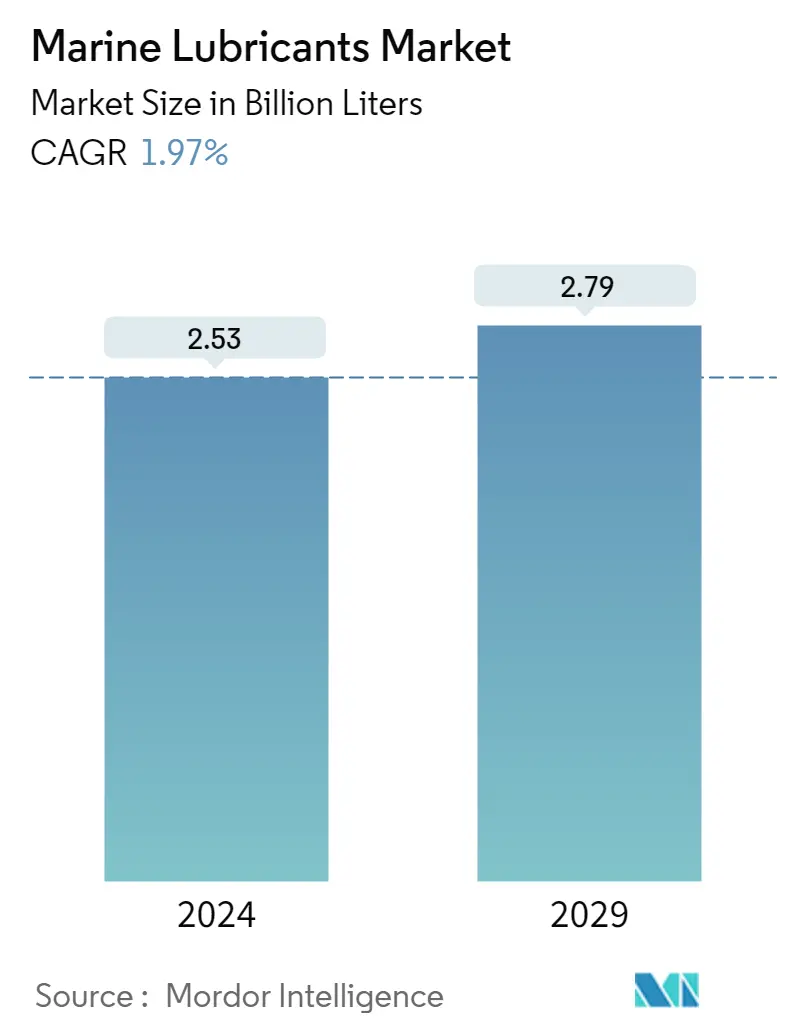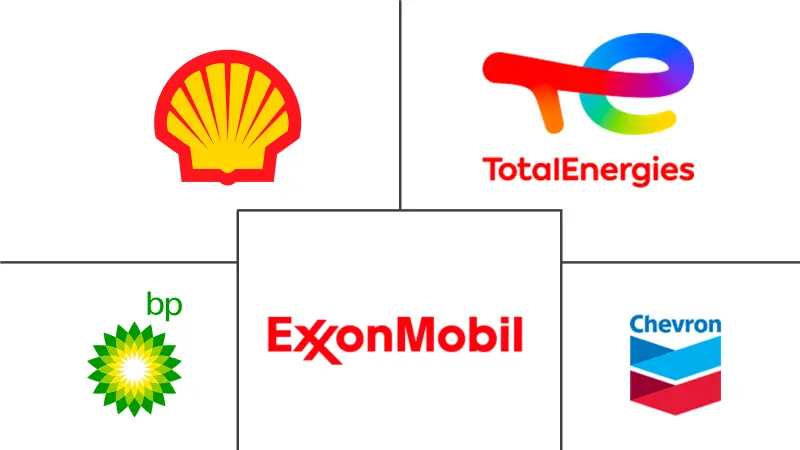Market Size of Marine Lubricants Industry

| Study Period | 2019 - 2029 |
| Base Year For Estimation | 2023 |
| CAGR (2024 - 2029) | 1.97 % |
| Fastest Growing Market | Asia Pacific |
| Largest Market | Asia Pacific |
| Market Concentration | Low |
Major Players
*Disclaimer: Major Players sorted in no particular order |
Marine Lubricants Market Analysis
The Marine Lubricants Market size is estimated at 2.53 Billion liters in 2024, and is expected to reach 2.79 Billion liters by 2029, growing at a CAGR of 1.97% during the forecast period (2024-2029).
The COVID-19 pandemic negatively impacted the market. It was because of the shutdown of the manufacturing facilities and plants due to the lockdown and restrictions. Supply chain and transportation disruptions further created hindrances for the market. However, the industry witnessed a recovery in 2021, thus rebounding the demand for the market studied.
- Over the short term, the rising demand for marine transport in Europe and Asia-Pacific and growing shipbuilding activities in Asia-Pacific are expected to drive the market demand during the forecast period.
- On the flip side, the development of synthetic and bio-based lubricants and volatility in raw material prices are anticipated to hinder the market's growth.
- However, the recovering shipbuilding and marine transport industries in the United States are projected to act as an opportunity for the market in the coming years.
- The Asia-Pacific region is expected to dominate the market and will also witness the highest CAGR during the forecast period.
Marine Lubricants Industry Segmentation
Marine lubricants are used in different sections and processes of containers, cargo fleets, oil tankers, and other ships for lubrication purposes. Marine lubricants include engine oils, hydraulic oils, compressor oils, slideways oils, gear oils, heat transfer oils, greases, turbine oils, and others. The marine lubricant market is segmented by lubricant type, ship type, and geography. By lubricant type, the market is segmented into system oil, marine cylinder lubricant, trunk piston engine oil, and other lubricant types. The market is segmented by ship type into bulker, tanker, container, and other ship types. The report also covers the market size and forecasts for marine lubricants in 15 countries across the major regions. Each segment's market sizing and forecasts are based on volume (million liters).
| Lubricant Type | |
| System Oil | |
| Marine Cylinder Lubricant | |
| Trunk Piston Engine Oil | |
| Other Lubricant Types |
| Ship Type | |
| Bulker | |
| Tanker | |
| Container | |
| Other Ship Types |
| Geography | |||||||
| |||||||
| |||||||
| |||||||
| |||||||
|
Marine Lubricants Market Size Summary
The marine lubricants market is poised for steady growth over the forecast period, driven by increasing demand for marine transport and shipbuilding activities, particularly in the Asia-Pacific region. The market experienced a setback due to the COVID-19 pandemic, which disrupted manufacturing and supply chains, but has since rebounded. The Asia-Pacific region is expected to dominate the market, benefiting from its robust shipbuilding industry and rising naval trade. Marine cylinder lubricants, essential for vessels with two-stroke engines, hold the largest market share, supported by the expanding merchant navy fleet and stringent environmental regulations prompting continuous product innovation by major manufacturers.
Despite the positive outlook, the market faces challenges from the development of synthetic and bio-based lubricants and fluctuating raw material prices. However, opportunities arise from the recovering shipbuilding and marine transport sectors in the United States. The market is partially consolidated, with key players like Exxon Mobil, BP (Castrol), Shell, Chevron, and TotalEnergies playing significant roles. Recent developments, such as capacity expansions and strategic acquisitions, indicate ongoing efforts to meet the growing demand for marine lubricants. The increasing global fleet of merchant ships and container vessels further underscores the market's potential for growth in the coming years.
Marine Lubricants Market Size - Table of Contents
-
1. MARKET DYNAMICS
-
1.1 Drivers
-
1.1.1 Rising Demand for Marine Transport in Europe and Asia-Pacific
-
1.1.2 Growing Shipbuilding Activities in Asia-Pacific
-
1.1.3 Other Drivers
-
-
1.2 Restraints
-
1.2.1 The Development of Synthetic Lubricants and Bio-Based Lubricants
-
1.2.2 Volatility in Raw Material Prices
-
1.2.3 Other Restraints
-
-
1.3 Industry Value Chain Analysis
-
1.4 Porter's Five Forces Analysis
-
1.4.1 Bargaining Power of Suppliers
-
1.4.2 Bargaining Power of Buyers
-
1.4.3 Threat of New Entrants
-
1.4.4 Threat of Substitute Products and Services
-
1.4.5 Degree of Competition
-
-
-
2. MARKET SEGMENTATION (Market Size in Volume)
-
2.1 Lubricant Type
-
2.1.1 System Oil
-
2.1.2 Marine Cylinder Lubricant
-
2.1.3 Trunk Piston Engine Oil
-
2.1.4 Other Lubricant Types
-
-
2.2 Ship Type
-
2.2.1 Bulker
-
2.2.2 Tanker
-
2.2.3 Container
-
2.2.4 Other Ship Types
-
-
2.3 Geography
-
2.3.1 Asia-Pacific
-
2.3.1.1 China
-
2.3.1.2 India
-
2.3.1.3 Japan
-
2.3.1.4 South Korea
-
2.3.1.5 Rest of Asia-Pacific
-
-
2.3.2 North America
-
2.3.2.1 United States
-
2.3.2.2 Mexico
-
2.3.2.3 Canada
-
-
2.3.3 Europe
-
2.3.3.1 Germany
-
2.3.3.2 United Kingdom
-
2.3.3.3 France
-
2.3.3.4 Italy
-
2.3.3.5 Rest of Europe
-
-
2.3.4 South America
-
2.3.4.1 Brazil
-
2.3.4.2 Argentina
-
2.3.4.3 Rest of South America
-
-
2.3.5 Middle East and Africa
-
2.3.5.1 Saudi Arabia
-
2.3.5.2 South Africa
-
2.3.5.3 Rest of Middle East and Africa
-
-
-
Marine Lubricants Market Size FAQs
How big is the Marine Lubricants Market?
The Marine Lubricants Market size is expected to reach 2.53 billion liters in 2024 and grow at a CAGR of 1.97% to reach 2.79 billion liters by 2029.
What is the current Marine Lubricants Market size?
In 2024, the Marine Lubricants Market size is expected to reach 2.53 billion liters.

